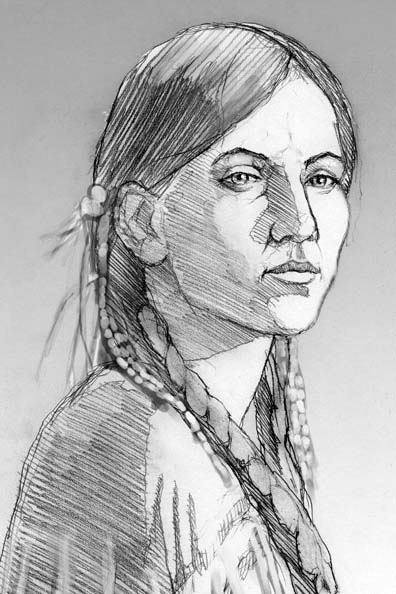Sacajawea
While this account has nothing to do with the Red River War, I found it to be very interesting that Sacajawea ended up with Indian tribes, probably Comanche or Kiowa, in the Texas Panhandle. This article was copied from the NUMU TEKWAPUHA NOMENEEKATU NEWSLETTER, Volume #14, Issue #4, Oct., Nov., Dec., 2011.
(Editor: More excerpts from ‘Neath August Sun, 1901)
SACAJAWEA
by Edith Connelley Clift, page 198
Sacajawea was one of the wives of Charbonneau, interpreter for Lewis and Clark. She was a Snake or Sho-sho-ne Indian girl of perhaps sixteen years. She was of unusual intelligence and appeal.
After a time of wandering (after the disbandment of the Lewis & Clark Expedition), Sacajawea joined the Comanche Indians, a related tribe of the Sho-sho-ne who lived on the Canadian River north of the present Amarillo, Texas.
Dr. Grace Raymond Hebard, who published a book titled “Sacajewea” wrote: …the language of these people she could understand and they in turn could understand her, for they were in fact a branch of the Sho-sho-nes… Here in the course of time Sacajawea married a member of this tribe, by the name of Jerk Meat. With this husband she lived harmoniously for a number of years, giving birth to five children, only two of whom survived.
One of these was a son called Ticannaf* and the other, the youngest of the five, a daughter named Yakee Wosi*, or Crying Basket.
Shortly after the birth of this child, Jerk Meat was killed in battle. From this time Sacajawea was „not in harmony with her husband‟s people‟ and decided to leave the Comanches and seek her own tribe….she so completely disappeared that her whereabouts was unknown for many years and the Comanche thereafter spoke of her as Watsi Wai?ipu, or Lost Woman.
When she left the Comanche she carried with her, her small daughter. Her Comanche son, Ticannaf, left behind, searched for her long and unsuccessfully.
The daughter of Sacajawea‟s son,
Ticannaf, was Tah-cu-tine*, or Ta-soonda-
hipe, translated to “Take Pity On.”
She resided within a few miles of
Lawton, Oklahoma, for many years and was the wife at the time of her death of Pah-we-tipe, who lived near Indiahoma.
A Dr. Alexander Eastman was
detailed to Lawton to talk with many of the aged Comanches to corroborate and verify the details of the life of
Sacajawea. Comanches commonly
seen on the streets of Lawton are
quoted at length in these reports. A few
of these are We-sa-poie, other of Tahcu-
tine‟s last husband; Mum-su-kih*,
brother of Tah-cu-tine‟s first husband;
George Ki-we-na*, Tah-cu-tine‟s
nephew; He-we-nah*, first cousin to
Tah-cu-tine; and Wm. Karty, nephew of
Hi-we-nah*. There are others among the Comanche who bear blood relationship to Sacajawea.
(*Editor‟s Note: I spent some time
researching the above information and
could find no mention of either Ticannaf
or Yakee Wosi in the early Comanche
census records.
Tah-cu-tine (or Tah-su-tine) also
known as Ta-soon-da-hipe, was married
to Ase-naw at one time. She was also
married to Pah-we-tipe, whose father
was Pe-sah-mock-ah and mother was
We-sah-poie, a Mexican Captive of the
Comanches. We-sah-poie was the
daughter of Si-ah-cheen-e-kah (Straight
Feather). (An interesting note: the home of Straight Feather still stands south of the
Lake Ellsworth Dam, about ¼ mile south
of the Highway, back in the timber, and
can be seen from the road. The house
is made of blocks and no longer has a
roof or windows.)
We-sa-poie was also the mother of
Ter-che-sy (also known as Pi-bitter). I
found no information on Mum-su-kih. I
wondered if Kiwena was actually
Koweno, and if Hi-we-nah and He-wenah
were the same name and could be a Comanche named Hi-we-ni, whom I found in old census records.) |


